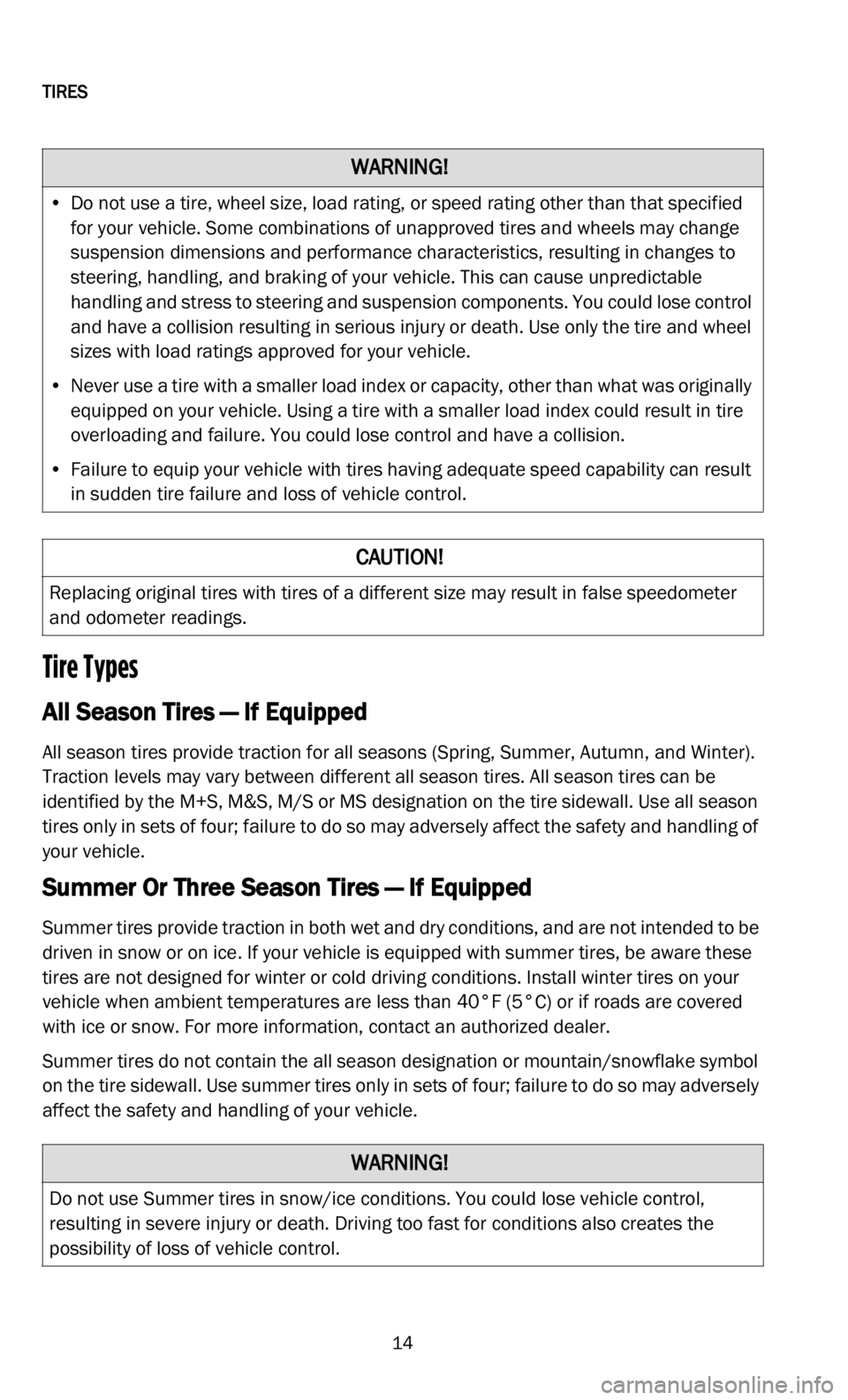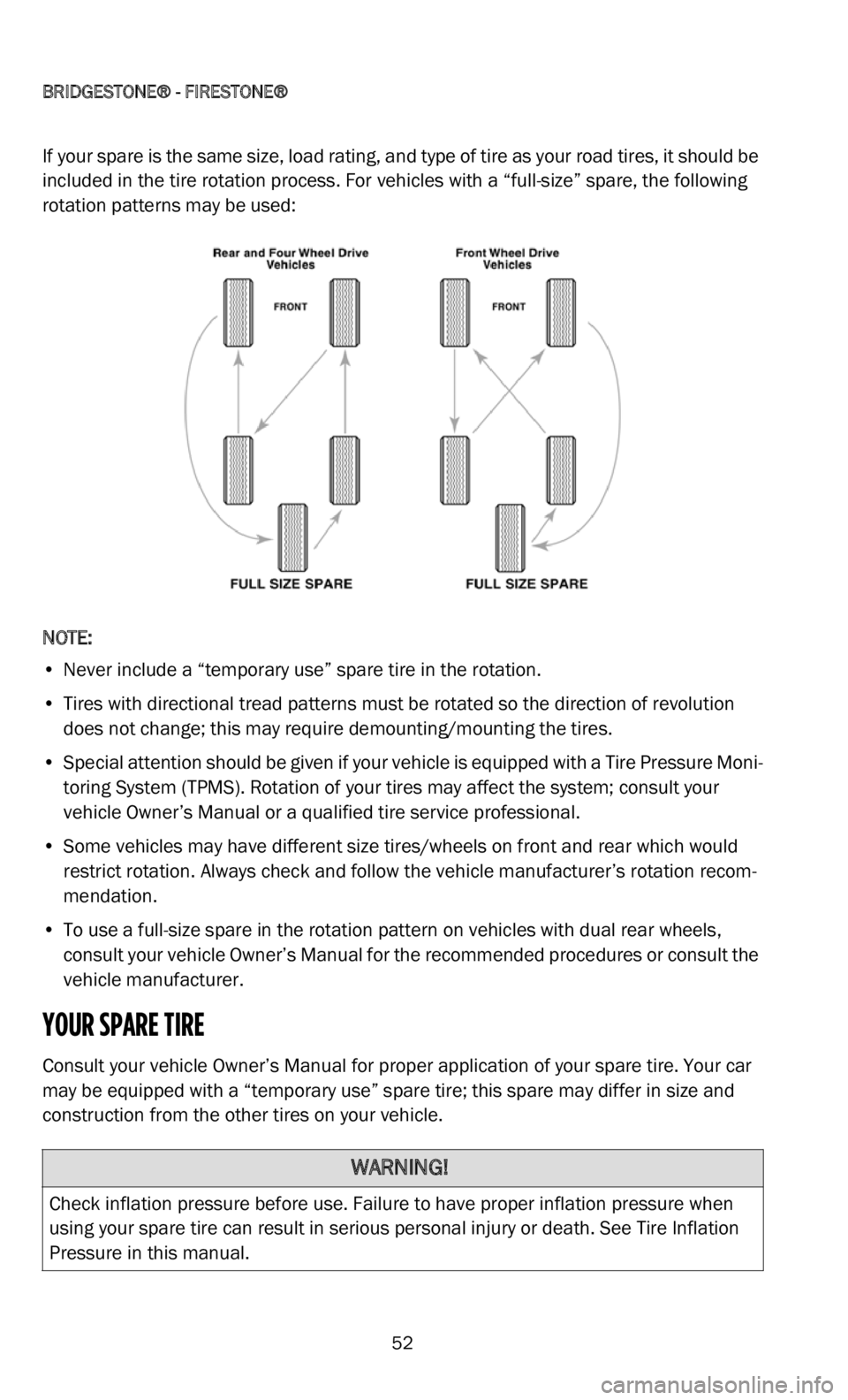change wheel DODGE DURANGO 2022 Vehicle Warranty
[x] Cancel search | Manufacturer: DODGE, Model Year: 2022, Model line: DURANGO, Model: DODGE DURANGO 2022Pages: 200, PDF Size: 6.72 MB
Page 15 of 200

TIRES
14
Tire Types
All Season Tires — If Equipped
All season tires provide traction for all seasons (Spring, Summer, Autumn, and Winter).
Traction levels may vary between different all season tires. All season tires can be
identified by the M+S, M&S, M/S or MS designation on the tire sidewall. Use all season
tires only in sets of four; failure to do so may adversely affect the safety and handling of
your vehicle.
Summer Or Three Season Tires — If Equipped
Summer tires provide traction in both wet and dry conditions, and are not intended to be
driven in snow or on ice. If your vehicle is equipped with summer tires, be aware these
tires are not designed for winter or cold driving conditions. Install winter tires on your
vehicle when ambient temperatures are less than 40°F (5°C) or if roads are covered
with ice or snow. For more information, contact an authorized dealer.
Summer tires do not contain the all season designation or mountain/snowflake symbol
on
the tire sidewall. Use summer tires only in sets of four; failure to do so may adversely
affect the safety and handling of your vehicle.
WARNING!
• Do not use a tire, wheel size, load rating, or speed rating other than that specified for your vehicle. Some combinations of unapproved tires and wheels may change
suspension dimensions and performance characteristics, resulting in changes to
steering, handling, and braking of your vehicle. This can cause unpredictable
handling and stress to steering and suspension components. You could lose control
and have a collision resulting in serious injury or death. Use only the tire and wheel
sizes with load ratings approved for your vehicle.
• Never use a tire with a smaller load index or capacity, other than what was originally eq
uipped on your vehicle. Using a tire with a smaller load index could result in tire
overloading and failure. You could lose control and have a collision.
• Failure to equip your vehicle with tires having adequate speed capability can result in
sudden tire failure and loss of vehicle control.
CAUTION!
Replacing original tires with tires of a different size may result in false speedometer
and odometer readings.
WARNING!
Do not use Summer tires in snow/ice conditions. You could lose vehicle control,
resulting in severe injury or death. Driving too fast for conditions also creates the
possibility of loss of vehicle control.
Page 31 of 200

BFGOODRICH® TIRES
30
REPLACEMENT OF TWO TIRES
It is recommended that all four tires are replaced at the same time. However, whenever
on
ly two tires are replaced, the new ones should be put on the rear. The new tires, with
deeper tread, may provide better grip and water evacuation in wet driving conditions.
CUSTOMIZATION OF TIRES, WHEELS, OR SUSPENSION ON SUVS AND LIGHT
TRUCKS
Due to their size, weight and higher center of gravity, vehicles such as SUVs and light
trucks do not
have the same handling characteristics as automobiles. Because of these
differing characteristics, failure to operate your SUV/truck in a proper and safe manner
can increase the likelihood of vehicle rollover. Modifications to your SUV/truck tire size,
tire type, wheels or suspension can change its handling characteristics and further
increase the likelihood of vehicle rollover. Whether your SUV/truck has the original
equipment configuration for tires, wheels and suspension or whether any of these items
have been modified, always drive safely, avoid sudden, sharp turns or lane changes and
obey all traffic laws. Failure to do so may result in loss of vehicle control leading to an
accident and serious injury or death.
TIRE ALTERATIONS
Do not make or allow to be made any alterations on your tires. Alterations may prevent
p r
oper performance, leading to tire damage which can result in an accident. Tires which
become unserviceable due to alterations such as trueing, whitewall inlays, addition of
balancing or sealant liquids, or the use of tire dressing containing petroleum distillates
are excluded from warranty coverage.
REPAIRS - WHEREVER POSSIBLE, SEE YOUR BFGOODRICH® TIRE RETAILER AT ONCE
If any BFGoodrich® tire sustains a puncture, have the tire demounted and thoroughly
i n
spected by any BFGoodrich® tire retailer for possible damage that may have occurred.
A tread area puncture in any BFGoodrich® passenger or light truck tire can be repaired
p r
ovided that the puncture hole is not more than 1/4 of an inch in diameter, not more
than one radial cable per casing ply is damaged, and the tire has not been damaged
further by the puncturing object or by running underinflated. Tire punctures consistent
with these guidelines can be repaired by following the Rubber Manufacturers Association
(RMA) recommended repair procedures.
TIRE REPAIRS
Repairs of all tires must be of the combined plug and inside patch type. Plug only repairs
are improper. A tire should be removed from the rim and inspected prior to repair. Any
tire repair done without removing the tire from the rim is improper. An improperly
repaired tire will cause further damage to the tire by either leaking air or allowing air,
moisture and contaminants to enter the structure of the tire. An improperly repaired tire
can fail suddenly at a later date.
Never repair a tire with less than 2/32 of an inch tread remaining. At this tread depth,
t h
e tire is worn out and must be replaced.
Page 33 of 200

BFGOODRICH® TIRES
32
FOLLOW THESE MOUNTING RECOMMENDATIONS
Tire changing can be dangerous and must be done by professionally trained persons
us
ing proper tools and procedures as specified by the Rubber Manufacturers
Association (RMA).
Your tires should be mounted on wheels of correct size and type and which are in good,
c le
an condition. Wheels that are bent, chipped, rusted (steel wheels) or corroded (alloy
wheels) may cause tire damage. The inside of the tire must be free from foreign material.
Have your retailer check the wheels before mounting new tires. Mismatched tires and
rims can explode during mounting. Also, mismatched tires and rims can result in
dangerous tire failure on the road. If a tire is mounted by error on the wrong-sized rim, do
not remount it on the proper rim — scrap it. It may have been damaged internally (which
is not externally visible) by having been dangerously stretched and could fail on the
highway.
Old valves may leak. When new tubeless tires are mounted, have new valves of the
c o
rrect type installed. Tubeless tires must only be mounted on wheels designed for
tubeless tires i.e., wheels which have safety humps or ledges.
It is recommended that you have your tires and wheels balanced. Tires and wheels which
a r
e not balanced may cause steering difficulties, a bumpy ride, and irregular tire wear.
Be sure that all your valves have suitable valve caps. The valve cap is the primary seal
a g
ainst air loss.
SERVICE LIFE FOR PASSENGER CAR AND LIGHT TRUCK TIRES INCLUDING SPARE
TIRES
The following recommendation applies to passenger car and light truck tires. Tires are
composed of various types of material and rubber compounds, having performance
properties essential to the proper functioning of the tire itself. These component
properties evolve over time. For each tire, this evolution depends upon many factors
such as weather, storage conditions, and conditions of use including load, speed,
inflation pressure, maintenance etc. to which the tire is subjected throughout its life. This
service-related evolution varies widely so that accurately predicting the serviceable life
of any specific tire in advance is not possible.
In addition to regular inspections and inflation pressure maintenance by consumers, it is
re
commended to have passenger car and light truck tires, including spare tires,
inspected regularly by a qualified tire specialist, such as a tire dealer, who will assess the
tire’s suitability for continued service. Tires which have been in use for five years or more
should continue to be inspected by a specialist at least annually.
Consumers are strongly encouraged to be aware not only of their tires’ visual condition
an
d inflation pressure but also of any change in dynamic performance such as increased
air loss, noise or vibration, which could be an indication that the tires need to be removed
from service to prevent tire failure.
Page 44 of 200

BRIDGESTONE® - FIRESTONE®
43
• Never exceed the Gross Vehicle Weight Rating (GVWR) or front/rear Gross Axle Weight Rating (GAWR) of your vehicle.
• C onsult your vehicle Owner’s Manual for load recommendations and special instruc -
t
ions such as for trailer/towing and snow plow installations.
TIRE DAMAGE, INSPECTION AND SERVICE LIFE
Evaluation and maintenance of your tires is important to their performance and the
service they provide to you. Over time and/or through use, the condition of a tire can
change from exposure to everyday road conditions, the environment, damaging events
such as punctures, and other external factors.
You should visually inspect your tires on a regular basis throughout their life, and you
sh
ould have your tires periodically evaluated by a qualified tire service professional when
your vehicle is serviced such as routine maintenance intervals, oil changes, and tire
rotations. In particular, note the following tips for spotting tire damage:
• A fter striking anything unusual in the roadway, have a qualified tire service profes -
s
ional demount the tire and inspect it for damage. A tire may not have visible signs of
d a
mage on the tire surface. Yet, the tire may suddenly fail without warning, a day, a
week, or even months later.
• I nspect your tires for cuts, cracks, splits or bruises in the tread and sidewall areas.
B
umps or bulges may indicate a separation within the tire body. Have your tire
inspected by a qualified tire service professional. It may be necessary to have it
removed from the wheel for a complete inspection.
• I nspect your tires for adequate tread depth. When the tire is worn to the built-in indi -
c
ators at 2/32 of an inch (1.6 mm) or less tread groove depth, or the tire cord or fabric
i s
exposed, the tire is dangerously worn and must be replaced immediately.
• I nspect your tires for uneven wear. Wear on one side of the tread or flat spots in the
t
read may indicate a problem with the tire or vehicle. Consult a qualified tire service
professional.
• I nspect your wheels also. If you have a bent or cracked wheel, it must be replaced.
•
Don’t forget to check the spare tire.
M
ake sure your tires, including the spare tire, continue to be regularly inspected after 5
y e
ars of service to determine if they can continue in service. Even when your tires appear
to be usable from their external appearance or the tread depth may have not reached
the minimum wear out depth, it is recommended that all tires (including spare tires and
“temporary use” spares) more than 10 years old be replaced with new tires.
WARNING!
Driving on damaged tires is dangerous. A damaged tire can suddenly fail causing
serious personal injury or death. Have your tires regularly inspected by a qualified tire
service professional.
Page 53 of 200

BRIDGESTONE® - FIRESTONE®
52
If your spare is the same size, load rating, and type of tire as your road tires, it should be
included in the tire rotation process. For vehicles with a “full-size” spare, the following
rotation patterns may be used:
NOTE:
• Never include a “temporary use” spare tire in the rotation.
•
Tires with directional tread patterns must be rotated so the direction of revolution
d
oes not change; this may require demounting/mounting the tires.
• S pecial attention should be given if your vehicle is equipped with a Tire Pressure Moni -
t
oring System (TPMS). Rotation of your tires may affect the system; consult your
v e
hicle Owner’s Manual or a qualified tire service professional.
• S ome vehicles may have different size tires/wheels on front and rear which would
r
estrict rotation. Always check and follow the vehicle manufacturer’s rotation recom -
mendation.
• T o use a full-size spare in the rotation pattern on vehicles with dual rear wheels,
c
onsult your vehicle Owner’s Manual for the recommended procedures or consult the
vehicle manufacturer.
YOUR SPARE TIRE
Consult your vehicle Owner’s Manual for proper application of your spare tire. Your car
may be equipped with a “temporary use” spare tire; this spare may differ in size and
construction from the other tires on your vehicle.
WARNING!
Check inflation pressure before use. Failure to have proper inflation pressure when
using your spare tire can result in serious personal injury or death. See Tire Inflation
Pressure in this manual.
Page 55 of 200

BRIDGESTONE® - FIRESTONE®
54
TIRE REGISTRATION
Registration of your tires is an important safety precaution since it enables the
manufacturer to notify you in the event of a recall. When you purchase replacement tires,
the retailer will provide a registration card on which the tire identification numbers have
been recorded; fill in your name and address on the card and mail it promptly. Some
retailers may submit the registration for you. You do not need to register tires which come
as original equipment on new vehicles—the vehicle and tire manufacturers handle that
for you.
RFT TIRES WITH RUN-FLAT TECHNOLOGY
If your vehicle is equipped with Bridgestone® or Firestone® brand RFT
tires, this chapter presents specific maintenance and safety issues
a s
sociated with these tires that are in addition to those covered elsewhere in this
manual.
What is RFT? Run-Flat Technology tires are extraordinary tires that utilize specially
d e
signed components to temporarily support your vehicle in the event of inflation
pressure loss, such as from a puncture. This gives you the ability to drive to a convenient
and safe location to change your tire (if equipped with a spare) or have it inspected for
possible repair or replacement.
Naturally, certain run-flat and low pressure operating limitations apply, which varies
ac
cording to the specific self-supporting tire design. Like all tires, during normal
operation, they must be properly inflated and maintained. Regardless of the design or
quality, no tire is indestructible.
RFT — How to Identify: B
ridgestone® and Firestone® brand tires are marked on the
sidewalls, near the wheel, with the RFT logo (shown above).
RFT INFLATION PRESSURE
Like other tires, RFT tires need proper inflation pressure maintenance for safe operation
an
d to achieve the maximum tire life and performance. Check inflation pressures
monthly and before long trips or carrying extra weight. Use an accurate tire gauge and
check pressures when the tires are cold. Follow the vehicle manufacturer’s
recommendation for inflation pressure settings as indicated on the vehicle tire
information placard and/or in the vehicle Owner’s Manual. Do not forget the spare, if
applicable. See “Tire Inflation Pressure” in this manual.
TIRE PRESSURE MONITORING SYSTEM (TPMS)
A functioning Tire Pressure Monitoring System (TPMS) must be used with your Run Flat
tires. These tires ride so well even without inflation pressure, the TPMS may be necessary
to alert you of an inflation pressure loss condition. When alerted, follow the instructions
in your vehicle Owner’s Manual and see “Run-Flat or Low Tire Pressure Operation,” the
following section in this manual.
Page 95 of 200

GOODYEAR® DUNLOP® TIRES
94
WHAT IS NOT COVERED BY THIS WARRANTY?
This limited warranty does not cover the following:
• Tires submitted for ride disturbance complaints that are worn beyond the first 2/32 of
a
n inch tread depth or tires submitted for ride disturbance due to damaged wheels or
any vehicle condition.
• G oodyear® does not warrant or give credit in any adjustment transaction for any kind
o
f material added to a tire (e.g., tire fillers, sealants, balancing substances) after the
tire leaves a factory producing Goodyear® or Dunlop® tires, nor will it adjust any tire
that has failed as a result of adding such material.
• I rregular wear or damage due to mechanical condition of the vehicle, improper infla -
t
ion, overloading, high speed spin-up, misapplication, misuse, negligence, racing, use
o f
tire chains, improper mounting or demounting, improper repair, wreck, collision or
fire.
• R oad hazards (includes, but is not limited to, punctures, cuts, snags, impact breaks,
e
tc.).
• A ny tire that, after leaving a factory producing Goodyear® or Dunlop® tires, has been
i
ntentionally altered to change its appearance (e.g., white inlay on a black tire or
regrooved).
• T ires with weather-cracking that were purchased more than four years prior to presen -
t
ation for adjustment or, if purchase date cannot be verified, manufactured more than
f o
ur years prior to presentation for adjustment.
• T emporary spare tires used on vehicles used in racing and on passenger cars in
s
pecial applications such as police pursuit service.
• G oodyear® Unisteel® Commercial Radial Light Truck Tires.
•
Tires removed from service due to improper repairs.
•
Tires supplied as Original Equipment are not eligible for any tread life warranty consid -
e
ration.
• C osmetic weather checking.
•
Tire Pressure Monitoring System (TPMS) – refer to vehicle manufacturer’s warranty.
•
Ultra High-Performance Summer tires are not recommended for Winter use, and tread
o
r shoulder cracking on those tires resulting from Winter use will not be covered under
our warranty.
WHAT ARE YOUR LEGAL RIGHTS?
No Representative or dealer has authority to make any representation, promise or
agreement on behalf of Goodyear®, except as stated herein. Any tire, no matter how well
constructed, may fail in service or otherwise become unserviceable due to conditions
beyond the control of the manufacturer. Under no circumstances is this warranty a
representation that a tire failure cannot occur.
DISCLAIMER: THIS WARRANTY IS IN LIEU OF, AND GOODYEAR® HEREBY DISCLAIMS,
AN
Y AND ALL OTHER WARRANTIES AND REPRESENTATIONS, EXPRESS OR IMPLIED,
Page 97 of 200

GOODYEAR® DUNLOP® TIRES
96
•TIRE SPINNING. On slippery surfaces such as snow, mud, ice, etc., do not spin tires in
excess of 35 mph (55 km/h), as indicated on the speedometer.
• EXCESSIVE WHEEL SPINNING.
This can also result in tire disintegration or axle failure.
TIRE CARE AND MAINTENANCE GUIDE
The easiest way to help ensure satisfactory mileage and performance from your
Goodyear® or Dunlop® tires is to give them a simple but frequent (at least monthly)
inspection for proper inflation, even tread wear and the presence of any damage.
DO MAINTAIN PROPER INFLATION PRESSURE IN YOUR TIRES
Proper inflation pressure is necessary for optimum tire performance, safety and fuel
economy. Check inflation pressures at least once a month and before long trips. Use an
accurate tire pressure gauge. Always check pressures when the tires are cold (when the
vehicle has been driven less than one mile). If you must check inflation when the tires
are hot, add 4 psi (27 kPa) to the recommended cold inflation pressure. It is difficult to
tell just by looking at radial tires whether they are underinflated.*
Furthermore, when operating a vehicle equipped with radial tires, it is difficult to notice
wh
en a tire has gone flat or nearly flat since the “feel” of the vehicle does not change
significantly.
*Evidence of air loss or repeated underinflation always requires expert inspection to
d e
termine the source of leakage and tire removal to determine repairability. To avoid
injury, NEVER attempt to reinflate a tire that has been run severely underinflated.
Progressive air loss may result from punctures, cuts, curbing, impacts or partial bead
unseating. Some fitment causes for air loss are (1) incomplete bead seating, (2) bead
tearing caused by a machine tool due to insufficient lubrication or improper adjustment.
Leaking valve core or rubber valve components should be replaced when problems are
detected and whenever tires are replaced.
WARNING!
Vehicle handling, traction, ride comfort and other performance parameters may be
significantly affected by a change in tire size or type. Before replacing tires, always
consult and follow the vehicle Owner’s Manual because some vehicle manufacturers
prohibit changing tire size. When selecting tires that are different from the original
equipment size make certain:
• The tires have adequate load-carrying capacity based on the vehicle placard.
•
The tires have sufficient inflation pressure to carry the load.
•
There is proper clearance with no interference points between the tire and vehicle.
T
he consumer must be aware to always drive safely and obey all traffic laws. Avoid
s u
dden, sharp turns or aggressive lane changes. Failure to follow any of these
warnings may result in loss of control of the vehicle, leading to an accident and
serious injury or death.
Page 112 of 200

KUMHO TIRES
111
4. The cost of applicable taxes and mounting and balancing and any other service charges.
5. T ire damage or irregular wear due to:
•
Road hazard, including puncture, cut, impact break, bulge, snag, stone drill, colli -
s
ion.
• C ontinued use while run flat or under acute underinflation.
•
Improper use or operation, without limitation, improper inflation pressure, over -
l
oading, use of an improper rim, tire/wheel assembly imbalance or other vehicle
c o
ndition, worn suspension components, improper mounting or de-mounting,
misuse, misapplication, fire or other externally generated heat, water or other
material trapped inside the tire during mounting, tire alteration, racing or compe -
tition purposes, improper inserting of sealant, balance or filler materials.
• Improper repair, or with repairs not conforming to the Rubber Manufacturers Asso -
c
iation standards, or with section repairs, or with self-vulcanizing plug only.
• F ailure to rotate the tire at least every 5,000 m
iles (8,047 km) as evidenced by
Ku
mho’s Mileage Warranty/Tire Rotation Card (printed in this brochure) or vehicle
misalignment.
• U neven or rapid wear which is caused by mechanical irregularity in the vehicle
s
uch as misalignment, (a measured tread difference of 2/32 of an inch or more
across the tread on the same tire).
6. O zone or weather cracking on tires over four (4) years from the date of manufacture.
7
. T ires that have been recapped, or retreaded, regrooved.
8
. R ide disturbance (out-of-round, vibration, pulling, etc.) claims submitted after the first
2
/32 of an inch of tread wear.
9. Lo ss of time, or use, inconvenience, or any incidental or consequential damage.
1
0.T ires that have been modified by the addition or removal of material or any tire inten -
t
ionally altered to change its appearance.
11.T ires unserviceability caused by the tire operation in excess of tire/wheel manufac -
t
urers specifications and recommendations.
12.T ires that are misapplied due to insufficient speed rating, or undersized, or oversized
t
ires.
13.T ires that have become unserviceable because chemical corrosion, vandalism,
c
hains and flat spotting.
14.T ires involved in any racing-related activities.
1
5.T his limited warranty applies only to the original purchaser and is nontransferable.
Page 134 of 200

MICHELIN®
133
Full-size Spare
Full-size spare tires (not temporary spares) of the same size and construction should be
u s
ed in a five tire rotation. Always check the inflation pressure of the full-size spare
immediately before incorporating it into rotation. Follow the vehicle manufacturer’s
recommended pattern for rotation, or if not available, see a qualified tire technician.
Replacement of Two Tires
It is recommended that all four tires are replaced at the same time. However, when only
t w
o tires are replaced, the new tires should be put on the rear. The new tires, with deeper
tread, may provide better grip and water evacuation in wet driving conditions.
CUSTOMIZATION OF TIRES, WHEELS, OR SUSPENSION ON SUVS AND LIGHT
TRUCKS
Due to their size, weight and higher center of gravity, vehicles such as SUVs and light
trucks do not have the same handling characteristics as automobiles. Because of these
differing characteristics, failure to operate your SUV/truck in a proper and safe manner
can increase the likelihood of vehicle rollover. Modifications to your SUV/truck tire size,
tire type, wheels or suspension can change its handling characteristics and further
increase the likelihood of vehicle rollover. Whether your SUV/truck has the original
equipment configuration for tires, wheels and suspension or whether any of these items
have been modified, always drive safely, avoid sudden, sharp turns or lane changes and
obey all traffic laws. Failure to do so may result in loss of vehicle control leading to an
accident and serious injury or death.
TIRE ALTERATIONS
Do not make or allow to be made any alterations on your tires. Alterations may prevent
proper performance, leading to tire damage which can result in an accident. Tires which
become unserviceable due to alterations such as truing, whitewall inlays, addition of
balancing or sealant liquids, or the use of tire dressing containing petroleum distillates
are excluded from warranty coverage.
REPAIRS WHEREVER POSSIBLE, SEE YOUR MICHELIN® TIRE RETAILER AT ONCE
If any MICHELIN® tire sustains a puncture, have the tire demounted and thoroughly
inspected by any MICHELIN® tire retailer for possible damage that may have occurred.
A tread area puncture in any MICHELIN® passenger or light truck tire can be repaired
provided that the puncture hole is not more than 1/4 inch in diameter, not more than
o n
e radial cable per casing ply is damaged, and the tire has not been damaged further
by the puncturing object or by running underinflated. Tire punctures consistent with
these guidelines can be repaired by following the US Tire Manufacturers Association
(USTMA) recommended repair procedures.
TIRE REPAIRS
Repairs of all tires must be of the combined plug and inside patch type. Your MICHELIN®
PAX® System tires must be removed from the wheel for inspection prior to repair. Plug
only repairs are improper. A tire should be removed from the rim and inspected prior to